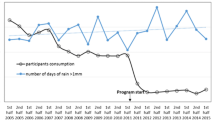Abstract
Efforts by municipal water agencies to improve demand end water use efficiency have focused largely on incentive programs and regulatory interventions. However, another important approach to achieving conservation targets is capacity-building, which may be particularly effective when target populations are motivated to improve their consumption efficiency but are lacking information or technology to do so. This case study considers a program by the Santa Clara Valley Water District (CA, USA) which aims to enable conservation among a group of consumers by providing information about current use and potential savings as well as optional access to water saving devices. The impact of this capacity building approach on consumption patterns was quantified by comparing water histories of program participants to a control group of similar sites within the District. Participating sites showed a net savings of 18.22 % when compared to the control group. The study demonstrates that capacity building approaches can effectively compliment other interventions such as conservation incentives to improve demand end water use efficiency.





Similar content being viewed by others
Abbreviations
- CII:
-
Commercial Industrial, and Institutional sectors such as restaurants, retailers, manufacturing facilities, and governmental buildings
- SCVWD:
-
Santa Clara Valley Water District
References
Bruch C, Altman S, Al-Moumin M, Troell J, Roffman E (2007) Legal framework governing water in the Middle East and North Africa. Int J Water Resour Dev 23:595–624
Bryan BA, Kandulu JM (2011) Designing a policy mix and sequence for mitigating agricultural non-point source pollution in a water supply catchment. Water Resources Management 25:875–892
Geyer-Allély E, Zacarias-Farah A (2002) Policies and instruments for promoting sustainable household consumption. J Clean Prod 11:923–926
Goldberg DH, Rajaniemi T, Gurevitch J, Stewart-Oaten A (1999) Empirical approaches to quantifying interaction intensity: competition and facilitation along productivity gradients. Ecology 80:1118–1131
Greiner R, Gregg D (2011) Farmers’ intrinsic motivations, barriers to the adoption of conservation practices and effectiveness of policy instruments: Empirical evidence from northern Australia. Land Use Policy 28:257–265
Gumbo B, Juzio D, van der Zaag P (2003) Information is a prerequisite for water demand management: experiences from four cities in Southern Africa. Phys Chem Earth 28:827–837
Gumbo B, Forster L, Arntzen J (2005) Capacity building in water demand management as a key component for attaining millennium development goals. Phys Chem Earth 30:984–992
Haddad BM (2000) Economic incentives for water conservation on the Monterey Peninsula: the market proposal. Journal of the American Water Resources Association 36:1–15
Jones N, Evangelinos K, Gaganis P, Plyzous E (2010) Citizens’ perceptions on water conservation policies and the role of social capitol. Water Resources Management 25:509–522
Jorgensen B, Graymore M, O’Toole K (2009) Household water use behavior: an integrated model. J Environ Manag 91:227–236
Kenney DS, Klein RA, Clark MP (2004) Use and effectiveness of municipal water restrictions during drought in Colorado. Journal of the American Water Resources Association 40:77–87
Kilgren DC, Endter-Wada J, Kjelgren RK, Johnson PG (2010) Implementing landscape water conservation in public school settings: a case for institutional problem solving. Journal of the American Water Resources Association 46:1205–1220
McKay J, Moeller A (2002) Are mandatory regulations required for water quality in Australia? Water Policy 4:95–118
Mulwafu W, Chipeta G, Chavula A, Ferguson B, Chilima NG (2003) Water demand management in Malawi: problems and prospects for its promotion. Phys Chem Earth 28:787–796
Olmstead SM (2010) The economics of managing scarce water resources. Review of Environmental Economics and Policy 4:179–198
Olmstead SM, Stavins RN (2009) Comparing price and non-price approaches to urban water conservation. Water Resour Res 45:WO4301
Roccaro P, Falciglia PP, Vagliasindi FGA (2011) Effectiveness of water saving devices and educational programs in urban buildings. Water Sci Technol 63:1357–1365
Schneider A, Ingram H (1990) Behavioral assumptions of policy tools. Journal of Politics 52:510–529
Smith WJ Jr, Wang Y (2008) Conservation rates: the best ‘new’ source of urban water during drought. Water and Environment Journal 22:100–116
WaterWise Consulting, Inc. (2009) Commercial, Industrial, Institutional Water Use Survey Program Final Report Fiscal Years 2007–2009. 1590 Oakland Rd, Suite B211, San Jose, CA (USA) 95131. (408) 496–6965.www.waterwise-consulting.com
Willis RM, Stewart RA, Panuwatwanich K, Jones S, Kyriakides A (2010) Alarming visual display monitors affecting shower end use water and energy conservation in Australian residential households. Resour Conserv Recycl 54:1117–1127
Acknowledgements
The author is grateful to Jerry de la Piedra, Karen Morvay Koppett, and Virginia O’Rourke of the Santa Clara water District’s Conservation Unit for providing the opportunity to conduct this study, to Robert Siegfried for many engaging conversations about data analysis, and to Daniel Press of the University of California Santa Cruz for inspiring my study of policy. Thank you to Eduardo Espericueta for creating the map presented in Figure 1. I extend my gratitude broadly to the staff and interns of the Santa Clara Valley Water District, Water Wise Consulting Inc., the City of Palo Alto, the City of San Jose, the City of Morgan Hill, and the many participating site managers in Santa Clara County for their assistance in the preparation of this study and for their ongoing efforts to conserve our precious water resources.
Author information
Authors and Affiliations
Corresponding author
Rights and permissions
About this article
Cite this article
Reed, L.K. Capacity Building as A Policy Instrument in Water Conservation: A Case Study on Commercial, Industrial, and Institutional Consumers. Water Resour Manage 26, 3819–3829 (2012). https://doi.org/10.1007/s11269-012-0105-2
Received:
Accepted:
Published:
Issue Date:
DOI: https://doi.org/10.1007/s11269-012-0105-2




